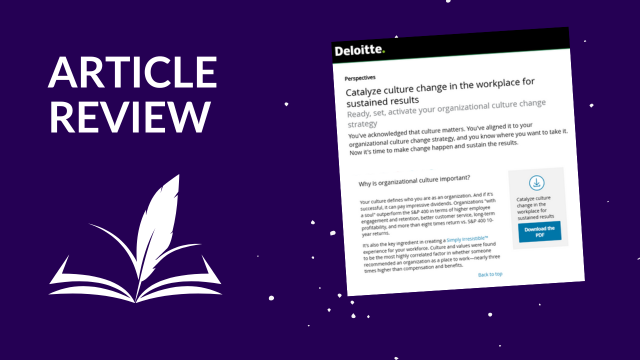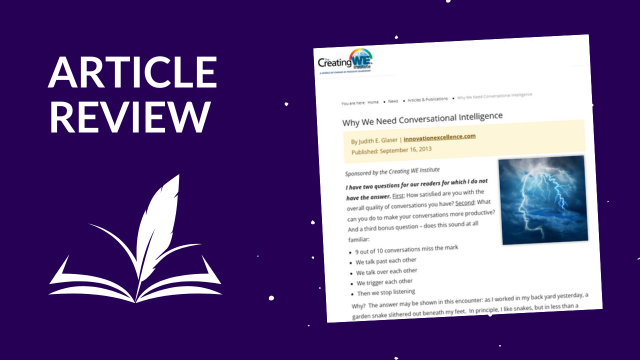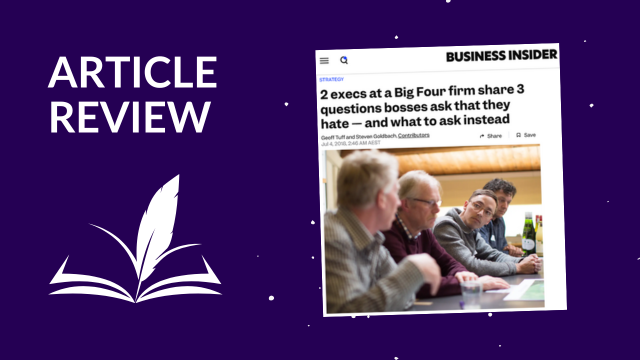Far too often when managing change, companies place their entire focus on the cut-and-dried aspects of organizational change – who will be performing what roles, and what tasks need to be accomplished? However, a much subtler process that management often fails to address simmers beneath the surface: the various emotional aspects of change. The delicate process of translating change to the entire organization in a digestible way is what will solidify success in the long term. Organizational stress, disagreement and resistance are inevitable, but with careful fine-tuning, these obstacles can serve as building blocks to strengthen relationships, clarify company culture and give each employee a sense of ownership in the change.
Three articles about the emotional side of change are highlighted below followed by brief summaries and commentary on how change management practitioners might incorporate any of the findings into their current practices.
- Lawrence, Eleanor, Ruppel, Cynthia P., and Tworoger, Leslie C., (2014). The Emotions and Cognitions During Organizational Change: The Importance of the Emotional Work for Leaders, Journal of Organizational Culture, Communications and Conflict, Volume 18, Number 1, pp. 257-273.
- Houston, Cynthia, and Paganelli, Andrea, (2015). An Exploratory Study of School Librarians’ Emotional Response to Change in the Workplace, WKW School of Communication & Information & NTU Libraries, Libres, Volume 25, issue 1, pp. 16-32.
- Klarner, Patricia, Todnem, Rune, and Diefenbach, Thomas, (2011). Employee emotions during organizational change–—Towards a new research agenda, Scandinavian Journal of Management, 27, pp. 332-340.
What Does This Mean for Practitioners?
Researchers in the Nova Southeastern University study found that leaders can improve employee engagement, reduce resistance and solidify the likelihood of long-term transitional success by managing emotions proactively. The study suggests a four-stage process including Acknowledging, Reacting, Investigating and ideally, Implementing. Each stage evokes different emotions from staff, and thus requires different, timely responses from leadership. Respectively, those necessary responses are: Support, Respect, Information and Reinforcement.
During the Nova study, top management executives reported a range of emotions, including fear of failure, a sense of being overwhelmed, discomfort and confusion. Five years into the study, executives felt significantly different, and in many cases, had far more clarity than they did early on. In many cases, there was more assurance, and several noted that the culture had changed significantly over the implementation period. Most importantly, participants noted that a strong belief in their careers and company values, along with guidance from leadership, kept them going during transition, showing how the emotional work required from leaders is heightened during organizational change.
The second study by Western Kentucky University researchers looked at differences in reactions when changes were imposed on employees versus initiated by employees. The primary results showed that during change, newer employees had more positive expectations, employees felt more positive when they were given a degree of control and overall, employees felt more positive as time went on. The most commonly experienced negative emotion was discouragement. However, attitudes improved over time regardless of whether or not the changes were externally imposed. While this research was particular to an educational setting, change leaders within organizations can extrapolate these key findings to better understand and accommodate their own employees’ reactions to change. Mainly, organizational change leaders can focus on implementing change as a team instead of simply imposing it within a hierarchical structure. They can also work to ease discouragement as employees work to transition into new roles and learn new skills.
The third study emphasizes the need for a more dynamic definition of emotions, as this helps leaders to understand how various emotions can exist simultaneously and shift throughout time. They split organizational change into two kinds: simultaneous and sequential, noting that employee emotions must be examined differently in each scenario. In the case where multiple changes are taking place, employees may become confused by conflicting messages or lump all changes into one muddled process. The researchers highlight the importance of paying attention to emotional contagion, or the tendency of certain emotional states to spread throughout teams during times of uncertainty. Ultimately, the third piece calls for change to be studied according to the specific context, instead of generalized for all change situations.
The record of organizational change failures emphasizes the need to consider all aspects of the individuals involved as well as the organization itself when implementing change. Change management professionals and the organizations within which they work can strongly benefit from the messages within these articles, especially the need for better understanding and more direct action on the part of leadership related to the emotional aspects of change. These studies indicate that negative emotions are felt during times of change — by both management and employees—and that these negative feelings may increase when several changes are taking place at the same time. There is a profound need for leadership and change managers to directly incorporate emotional management into their organizational change plans. Whether this includes more one-on-one meetings, group discussions of existing problems or formal feedback systems to analyze shifts in the emotional environment as a means of gauging implementation, change practitioners now have research to support the actions they take to ease negative emotional responses. Thus increasing communication, providing support and lessening feelings of fear, self-doubt and uncertainty are paramount in creating meaningful and lasting change.
Related: 70 Years of Thought on Resistance Part 1







